| When it comes to stop-motion animation, there's Ray Harryhausen and then there's everyone else. Since we’ve looked at some of Harryhausen’s creatures and films elsewhere in this issue, I thought it would be fun to turn the spotlight to some stop-motion monster classics, and not-so classics, from other frame-by-frame puppeteers. Here are some blog-ish (or should I say Blob-ish?) ramblings by ye ole editor with no particular point. It's a sort of "scream of consciousness" piece. So let the stop-motion start! |
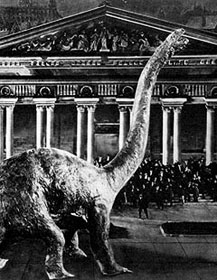 Since the early days of movies, stop-motion and dinosaurs have gone hand in hand. Willis O’Brien pioneered stop-motion effects in the silent era, bringing dinosaurs to life as early as 1915 in comedy shorts like THE DINOSAUR AND THE MISSING LINK and R.F.D. 10,000 B.C. A 1918 fantasy short, THE GHOST OF SLUMBER MOUNTAIN, featured more realistic stop-motion dinosaurs. These early works can be viewed on YouTube by clicking here. Since the early days of movies, stop-motion and dinosaurs have gone hand in hand. Willis O’Brien pioneered stop-motion effects in the silent era, bringing dinosaurs to life as early as 1915 in comedy shorts like THE DINOSAUR AND THE MISSING LINK and R.F.D. 10,000 B.C. A 1918 fantasy short, THE GHOST OF SLUMBER MOUNTAIN, featured more realistic stop-motion dinosaurs. These early works can be viewed on YouTube by clicking here.
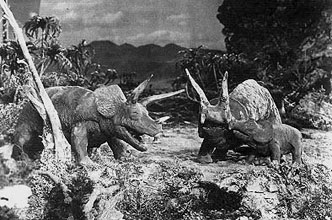 In 1925 O’Brien startled movie audiences with a whole world of life-like dinosaurs in THE LOST WORLD. The movie was also the first to have a prehistoric monster loose in the streets of a modern city, an idea repeated countless times in the future. Of course, that was the theme of O’Brien’s next big movie and his crowning achievement... In 1925 O’Brien startled movie audiences with a whole world of life-like dinosaurs in THE LOST WORLD. The movie was also the first to have a prehistoric monster loose in the streets of a modern city, an idea repeated countless times in the future. Of course, that was the theme of O’Brien’s next big movie and his crowning achievement...
|
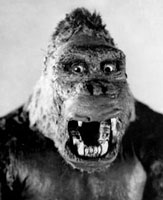 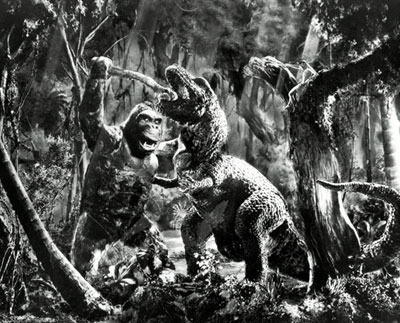 KING KONG. KING KONG.
“The stuff for which movies were made!” shouted the trailers. For once, the publicity was absolutely true. The world that Kong inhabits could only have existed through the magic of the movies and the skills of talented effects artists and technicians like Willis O’Brien.
Imagine being in the audience during the movie's original release and seeing the monstrous ape battle the hissing, snapping Tyrannosaurus. You would have been witnessing things you had never seen or heard before, and never could have up until then. It was state of the art and then some in 1933. Kong thrilled millions and changed the life of a teenaged Ray Harryhausen whose mission became clear the day he first saw KING KONG.
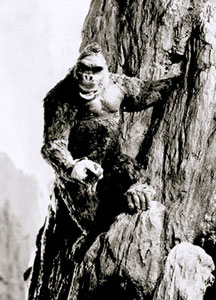 Two re-makes and scores of spin-offs and imitators have followed, but the original KONG is still King and still a marvel of ingenuity, artistry and imagination. Two re-makes and scores of spin-offs and imitators have followed, but the original KONG is still King and still a marvel of ingenuity, artistry and imagination. 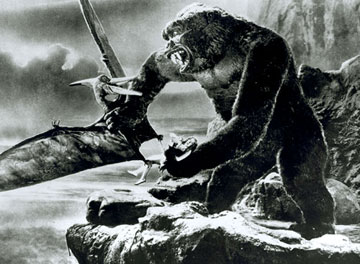 Young viewers of today might think that it looks crude or even funny compared to the near-seamless computer effects of the mega-million dollar Peter Jackson version and other modern effects movies. But if they can look at the original with the proper perspective, they might just realize what a groundbreaking and remarkable film it was and still is and come to appreciate the genius of men like Willis O’Brien. Young viewers of today might think that it looks crude or even funny compared to the near-seamless computer effects of the mega-million dollar Peter Jackson version and other modern effects movies. But if they can look at the original with the proper perspective, they might just realize what a groundbreaking and remarkable film it was and still is and come to appreciate the genius of men like Willis O’Brien.
|
 Carl Denham said to little Kong Jr., "You're not a patch on your old man". Truer words were never spoken of THE SON OF KONG. Although it is an enjoyable little romantic adventure film Carl Denham said to little Kong Jr., "You're not a patch on your old man". Truer words were never spoken of THE SON OF KONG. Although it is an enjoyable little romantic adventure film  and it gives us an amusing look at what the aftermath of Kong's New York rampage is for his captor (who is being sued by everyone in town), it's a decidedly unworthy sequel to one of the greatest monster films of all time. Done quickly to cash in on the success of the original, THE SON OF KONG doesn't even try to deliver the thrills of the first movie. It settles instead for humor and a melodrama. Willis O’Brien again supervised the effects, but it's uncertain whether or not he personally did any of the animation this time around. and it gives us an amusing look at what the aftermath of Kong's New York rampage is for his captor (who is being sued by everyone in town), it's a decidedly unworthy sequel to one of the greatest monster films of all time. Done quickly to cash in on the success of the original, THE SON OF KONG doesn't even try to deliver the thrills of the first movie. It settles instead for humor and a melodrama. Willis O’Brien again supervised the effects, but it's uncertain whether or not he personally did any of the animation this time around.
There was a long dry spell in stop-motion monsters after THE SON OF KONG. A Willis O’Brien project called WAR EAGLES, sadly, never took flight. Finally in 1949 MIGHTY JOE YOUNG became sort of the final part of the Cooper/ Schoedsack/ O’Brien giant ape trilogy, although the animation was chiefly done by O’Brien’s new protégé (along with Pete Peterson) so it's usually thought of as a Ray Harryhausen film. |
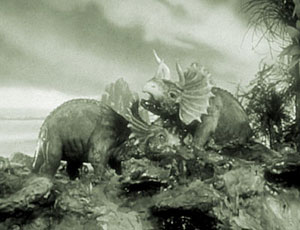 With a cheapie called LOST CONTINENT (1951) stop-motion dinosaurs made a rather unimpressive return to the screen. With a cheapie called LOST CONTINENT (1951) stop-motion dinosaurs made a rather unimpressive return to the screen.  The animation by Edward Nassour was pretty crude. The dinosaur models looked stiff and the stop-motion was shot two frames at a time, making the process go faster but also making the movements less smooth. The movie is pretty dull overall, interesting mostly for the cast that features Caesar Romero, Hugh Beaumont and Acquanetta. But if you grew up watching MAKE ROOM FOR DADDY in the '60s, you're sure to get a little misty when Sid Melton gets gored to death by a Triceratops. The animation by Edward Nassour was pretty crude. The dinosaur models looked stiff and the stop-motion was shot two frames at a time, making the process go faster but also making the movements less smooth. The movie is pretty dull overall, interesting mostly for the cast that features Caesar Romero, Hugh Beaumont and Acquanetta. But if you grew up watching MAKE ROOM FOR DADDY in the '60s, you're sure to get a little misty when Sid Melton gets gored to death by a Triceratops.
In 1953 Harryhausen's reign as king of stop-motion movie monsters began with THE BEAST FROM 20,000 FATHOMS, followed quickly by a string of sci-fi films for Columbia. Probably inspired by the popularity of those films, there was a rash of other stop-motion features in the late '50s. |
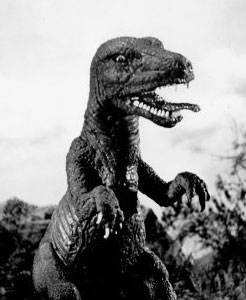 THE BEAST OF HOLLOW MOUNTAIN (1956) took an awfully long time to finally get to the ten good minutes of dinosaur scenes. That's "good" in the sense that the monster scenes are always the "good" part. The dinosaur itself and the animation were merely passable. THE BEAST OF HOLLOW MOUNTAIN (1956) took an awfully long time to finally get to the ten good minutes of dinosaur scenes. That's "good" in the sense that the monster scenes are always the "good" part. The dinosaur itself and the animation were merely passable. 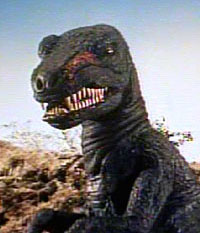 Reportedly, the stop-motion was done uncredited by director Edward Nassour who had handled the animation in LOST CONTINENT. This was a slight improvement, from the earlier animation, but only slight. Reportedly, the stop-motion was done uncredited by director Edward Nassour who had handled the animation in LOST CONTINENT. This was a slight improvement, from the earlier animation, but only slight.
The Beast's two most outstanding traits were a tongue that would make Gene Simmons jealous and an Elvis-like sneer. If he had only learned to play the guitar he might have had a different career where the biggest danger is just a mosh pit, not a quicksand pit.
Willis O'Brien, who seemed to have a million ideas for unrealized movies (all built around giant monsters and dinosaurs), received story credit but did not work on the effects. |
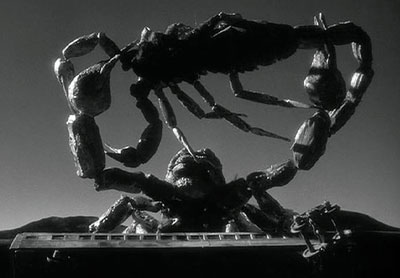 Without a doubt, the best non-Harryhausen stop-motion film of the '50s was THE BLACK SCORPION (1957). In fact, it's one of the best of the "big bug" movies of that time along with TARANTULA and THEM!. Its effectiveness is due in no small part to the natural fear most people have of those wicked looking little arachnids. I mean, pinchers, eight spider-like legs, a plated, flesh-colored body and a whip-like tail with a barbed stinger on it? Come on! Without a doubt, the best non-Harryhausen stop-motion film of the '50s was THE BLACK SCORPION (1957). In fact, it's one of the best of the "big bug" movies of that time along with TARANTULA and THEM!. Its effectiveness is due in no small part to the natural fear most people have of those wicked looking little arachnids. I mean, pinchers, eight spider-like legs, a plated, flesh-colored body and a whip-like tail with a barbed stinger on it? Come on!
Like most insects, the structure of a scorpion lends itself well to stop-motion and Willis O'Brien's crew did an excellent job of making them move naturally. The actual animation was done mostly by Pete Peterson. Two scenes in particular stand out. 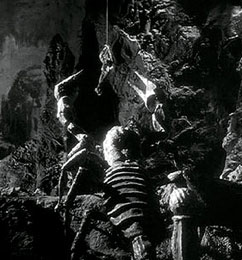 One is when the heroes (and a stowaway kid) are lowered deep into the caverns that the scorpions call home. The caves have an otherworldly feel to them, a little like Kong's Skull Mountain lair. And there are guest appearances by other icky insect life, some of which are rumored to be leftover from the spider pit scene cut from KING KONG. One is when the heroes (and a stowaway kid) are lowered deep into the caverns that the scorpions call home. The caves have an otherworldly feel to them, a little like Kong's Skull Mountain lair. And there are guest appearances by other icky insect life, some of which are rumored to be leftover from the spider pit scene cut from KING KONG.
 The other big scene is when the scorpions derail a train and devour all the occupants. That's also when Big Blackie decides to let the other scorpions know who's boss in the most direct way possible - by killing them all. The other big scene is when the scorpions derail a train and devour all the occupants. That's also when Big Blackie decides to let the other scorpions know who's boss in the most direct way possible - by killing them all.
An annoying technique that was common to stop-motion monster films was the use of a large prop head for close-up inserts. 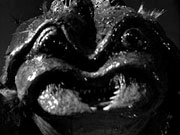 The heads usually take you out of the movie every time they pop up because of the jarring differences between them and the stop-motion models. It was true even in KING KONG but it's especially bad in THE BLACK SCORPION. The excitement of the animated action hits a speed bump every time they cut to a close-up of a much too human-looking scorpion face with drool constantly dripping from its grinning mouth. The repeated use of the prop head is the movie's biggest drawback, but still, it's a grisly gem of a giant bug movie. The heads usually take you out of the movie every time they pop up because of the jarring differences between them and the stop-motion models. It was true even in KING KONG but it's especially bad in THE BLACK SCORPION. The excitement of the animated action hits a speed bump every time they cut to a close-up of a much too human-looking scorpion face with drool constantly dripping from its grinning mouth. The repeated use of the prop head is the movie's biggest drawback, but still, it's a grisly gem of a giant bug movie. |
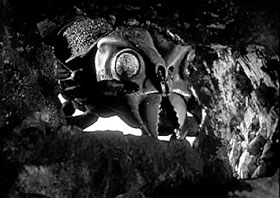
MONSTER FROM GREEN HELL (1958) is an odd little B-movie (no pun intended) about giant bugs loose in central Africa, the result of an experiment sending wasps into space. There's not a lot required from the stop-motion. The wings of the monster wasps are too small for them to fly so they just creep along the ground with their tiny wings buzzing. The most interesting effects scene is a quick fight between a wasp and a stop-motion python. |
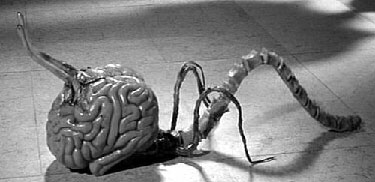
Some of the weirdest stop-motion monsters of the '50s were found in FIEND WITHOUT A FACE (1958). A change of pace from dinosaurs and giant bugs, these sickening critters were slimy human brains with antennae and spinal cord tails used to crawl along like inchworms or spring onto their victim’s throats. And did I mention they gurgle and sputter when they're killed? Is this a cool movie or what? |
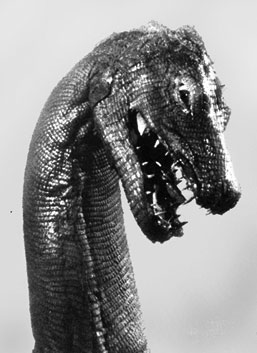 THE GIANT BEHEMOTH (1959) was a sort of British version of THE BEAST FROM 20,000 FATHOMS. In fact it's from the same director and co-writer, Eugene Laurie, who even went on to direct another similar movie, GORGO, that same year. Willis O'Brien and Pete Peterson were on the effects team. O'Brien must have felt some sense of Deja Vu when the monster was running amok in the streets of London much like the ending of THE LOST WORLD. THE GIANT BEHEMOTH (1959) was a sort of British version of THE BEAST FROM 20,000 FATHOMS. In fact it's from the same director and co-writer, Eugene Laurie, who even went on to direct another similar movie, GORGO, that same year. Willis O'Brien and Pete Peterson were on the effects team. O'Brien must have felt some sense of Deja Vu when the monster was running amok in the streets of London much like the ending of THE LOST WORLD.
It's a very intelligent but rather grim film with an almost dismal atmosphere, probably due partly to the constant overcast skies. But aside from the weather there are other downers. A girl sees her father die from horrible radiation burns. The helicopter carrying a lovably eccentric little paleontologist is blown up by the radioactive heat of the Behemoth. A man and his son become charred remains as the radiation-spewing creature passes by. We see a little girl playing with her doll on a ferry crossing the Thames just before the boat is overturned by you-know-who. We then witness many of the ferry passengers drowning and when all the screams and splashing have stopped, we see the little girl's doll floating alone in the river. Very few laughs. Even after the monster is destroyed, the film ends with a radio report that lets us know there may be more of the creatures out there.
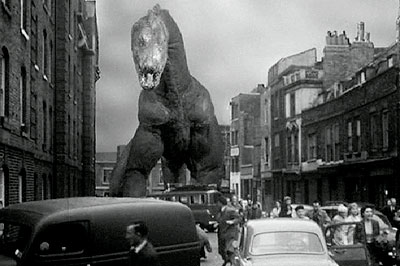 The construction of the Behemoth model is a little unusual. Like the models in KING KONG and other early films, it wasn't sculpted and cast in foam rubber, but was built up in layers of various materials over the metal armature. But unlike most stop-motion models, the Behemoth had a skin. It appears exactly like pieces of reptile skin were sewn around the figure. More likely the model maker made molds from a real lizard or snake skin and cast strips of textured rubber, which were sewn or glued to the surface of the model. As a result, the monster has a sort of patchwork look with lots of visible seams. At the same time, in certain scenes the skin gives it a more life-like appearance by forming natural folds and wrinkles when the neck twists and turns. The construction of the Behemoth model is a little unusual. Like the models in KING KONG and other early films, it wasn't sculpted and cast in foam rubber, but was built up in layers of various materials over the metal armature. But unlike most stop-motion models, the Behemoth had a skin. It appears exactly like pieces of reptile skin were sewn around the figure. More likely the model maker made molds from a real lizard or snake skin and cast strips of textured rubber, which were sewn or glued to the surface of the model. As a result, the monster has a sort of patchwork look with lots of visible seams. At the same time, in certain scenes the skin gives it a more life-like appearance by forming natural folds and wrinkles when the neck twists and turns.
The animation was very well done with the stark lighting adding greatly to many scenes. The creature coming ashore and encountering some high voltage lines is a marvelous bit of character animation. Unfortunately, it's one of the few such moments the animators got a chance to do. Most of the time, our star is just walking through streets stepping on things and knocking things down.
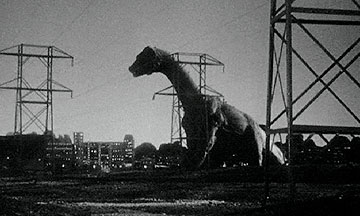 The major flaw in the effects scenes has to be the obvious repetition of certain footage to make the scenes longer without doing more animation. We see the monster smash the same car three times within a little over a minute. At times the shots are blown up in an attempt to hide the recycling, but that only makes it worse because of the distracting change in the quality of the picture. And then there's our old nemesis, the prop head. Despite these drawbacks, THE GIANT BEHEMOTH is a pretty engrossing film, even in the slow parts, and pretty exciting when it gets moving. The major flaw in the effects scenes has to be the obvious repetition of certain footage to make the scenes longer without doing more animation. We see the monster smash the same car three times within a little over a minute. At times the shots are blown up in an attempt to hide the recycling, but that only makes it worse because of the distracting change in the quality of the picture. And then there's our old nemesis, the prop head. Despite these drawbacks, THE GIANT BEHEMOTH is a pretty engrossing film, even in the slow parts, and pretty exciting when it gets moving.
In a way, BEHEMOTH is the last of its kind. The '50s were coming to a close and with them, an era of black and white, atomic age sci-fi films that now have a timeless charm. |
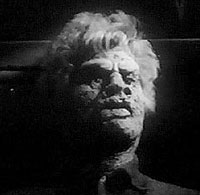 Speaking of the atomic age, I thought I'd make a quick mention of a title you probably wouldn't expect to find here. ATOM AGE VAMPIRE (1960) is an Italian horror film with a real actor, not a puppet, playing the monster. But for the few moments when the mad scientist is transforming into the title character, a stop-motion model of the actor was used. It was an odd choice but it's fairly well done and it may be the most memorable scene in the movie. Speaking of the atomic age, I thought I'd make a quick mention of a title you probably wouldn't expect to find here. ATOM AGE VAMPIRE (1960) is an Italian horror film with a real actor, not a puppet, playing the monster. But for the few moments when the mad scientist is transforming into the title character, a stop-motion model of the actor was used. It was an odd choice but it's fairly well done and it may be the most memorable scene in the movie.
 Click arrow to continue Click arrow to continue
|


 One is when the heroes (and a stowaway kid) are lowered deep into the caverns that the scorpions call home. The caves have an otherworldly feel to them, a little like Kong's Skull Mountain lair. And there are guest appearances by other icky insect life, some of which are rumored to be leftover from the spider pit scene cut from KING KONG.
One is when the heroes (and a stowaway kid) are lowered deep into the caverns that the scorpions call home. The caves have an otherworldly feel to them, a little like Kong's Skull Mountain lair. And there are guest appearances by other icky insect life, some of which are rumored to be leftover from the spider pit scene cut from KING KONG.
 The heads usually take you out of the movie every time they pop up because of the jarring differences between them and the stop-motion models. It was true even in KING KONG but it's especially bad in THE BLACK SCORPION. The excitement of the animated action hits a speed bump every time they cut to a close-up of a much too human-looking scorpion face with drool constantly dripping from its grinning mouth. The repeated use of the prop head is the movie's biggest drawback, but still, it's a grisly gem of a giant bug movie.
The heads usually take you out of the movie every time they pop up because of the jarring differences between them and the stop-motion models. It was true even in KING KONG but it's especially bad in THE BLACK SCORPION. The excitement of the animated action hits a speed bump every time they cut to a close-up of a much too human-looking scorpion face with drool constantly dripping from its grinning mouth. The repeated use of the prop head is the movie's biggest drawback, but still, it's a grisly gem of a giant bug movie.
